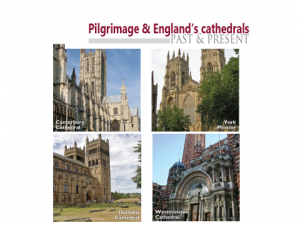As you know from this blog, the research focus of this Religious Studies department is ‘contemporary religion in historical perspective.’
Fortunately for me, this is at the heart of ‘Pilgrimage and England’s cathedrals, past and present’, the AHRC-funded, three-year research project which commenced in November 2014. Working as a Co-I with Dee Dyas, University of York (PI), Simon Coleman, University of Toronto (Co-I) and post-doctoral researchers Dr John Jenkins and Dr Tiina Sepp (both based at University of York), we have had a busy, fascinating and stimulating year, as you can see from the project website http://www.pilgrimageandcathedrals.ac.uk/
This project asks two key questions: Why did pilgrimage matter in the past and why does it still matter today? Cathedrals are amongst the most visible, distinctive and longest-lasting buildings in our cities, and this project is a fantastic opportunity to trace their shifting but continued significance in English urban and religious life. The project centres on in-depth historical and contemporary case studies of four cathedrals – Canterbury Cathedral, York Minster, Durham Cathedral and Westminster Cathedrals – chosen to represent a range of historical, geographical, social and denominational settings. Using a combination of methods, the researchers are examining pilgrimage and engagement with sacred sites in England from the 11th to the 21st centuries, and assessing the growing significance of England’s cathedrals as sacred/heritage/tourist sites today.
As well as seeing growing congregations, England’s cathedrals are visited by a large and diverse group of people. A recent report revealed that 27 per cent of adults resident in England had visited an Anglican cathedral at least once in the previous year. Of those visitors, over 40 per cent came from faith traditions other than Christianity or had no religious affiliation. We are working across academic disciplines with those connected with cathedrals every day (volunteers, vergers, clergy, education workers, administrators, shop managers to name but a few) and with visitors of all sorts (including heritage tourists, locals, worshippers and self-identified pilgrims) to increase our understanding and appreciation of these multivalent, multi-purpose meeting-places and significant spaces.
It’s been a huge pleasure to start to get to know our four partner Cathedrals, each with its own distinct history, architecture, location, local and national significance, vision and character. Using questionnaires, interviews and many fascinating conversations, Tiina, Simon and I have been working with visitors and service providers, helping to get a clearer picture of what is happening in relation to cathedrals – and indeed the broader socio-religious scene – in 21st century England. Meanwhile, Dee and John have been conducting in-depth historical research on Canterbury, York and Durham, uncovering some fascinating details which really enhance our understanding of the pilgrim experience of the past. Furthermore, among the outcomes of the project will be the construction of an interactive animated visualization of medieval pilgrims’ experience at Canterbury Cathedral, helping contemporary visitors to ‘read’ the Cathedral now and get a clearer sense of what it was like to visit then.
Over the next couple of years, the project research will result in books, journal articles, conferences, a website and resources for schools and the general public, and workshops with those involved with Cathedrals, playing a part in presenting new perspectives on visitor experiences and provision, strategies for dealing with an increasingly diverse range of visitors, and heritage management in English cathedrals.
Do follow our progress through our website, and I will be also be sharing some highlights and curiosities arising from ‘Pilgrimage and England’s cathedrals, past and present’ research here in the coming months.
Dr Marion Bowman

